August 25, 1942:
- August 25-26: "Thousands of Jews from Miedzyrzec, Poland, are deported to the Treblinka death camp.
- August 25-26: "Nearly 1000 Belgian Jews, including 232 children, are deported to the East."
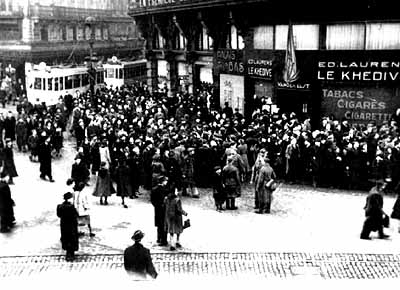
"The capitulation of Belgium to Germany on May 28, 1940, brought approximately 65,000 Jews under Nazi domination.
Tragically, many of these Jews had previously fled from Germany and Austria, thinking they had found a safe haven.
For most such Jews, the Nazi shadow of death could not be avoided.
"At the beginning of the occupation, Jewish businesses and individuals were registered.
In 1941 formal Jewish councils (Judenräte) were created.
When Jews were ordered to wear yellow badges in May 1942, the lack of cooperation on the part of Belgian officials enabled many Jews to go into hiding.
"Against a wave of opposition, the deportation of Jews from Belgium began in the summer of 1942.
Public protests raised on behalf of the Jews, coupled with the intervention of Belgium's queen mother, forced the Nazis to focus their efforts on the thousands of foreign Jews living in Belgium.
While many Belgian Jews went underground, others were deported from Belgian soil to the gas chambers at Auschwitz--more than 16,000 from August to October 1942.
"By the time the killings at Auschwitz ended in October 1944, approximately 29,000 of the Jews who had been living in Belgium when the Germans captured the country were dead."
August 26, 1942:
- "After being unloaded at the Treblinka death camp, a Jew named Friedman uses a razor blade to cut the throat of a Ukrainian guard. SS guards retaliate by immediately opening fire on the other newly arrived deportees."
- "518 Jewish children deported from Paris are gassed at Auschwitz."
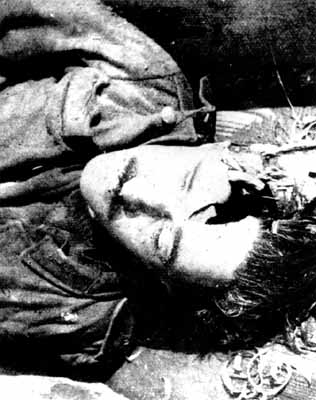
"Jasenovac, the largest of the Croatian concentration and death camps, was established in autumn 1941.
It became the final destination for some several hundred thousand Gypsies, Serbs, and Jews.
As this man's battered and broken skull shows, the camp, run by the Ustasa, was especially barbaric.
Thousands were murdered outright or simply starved to death as a result of the inhuman conditions.
In 1942 some 12,000 Jewish and Serbian children were executed."
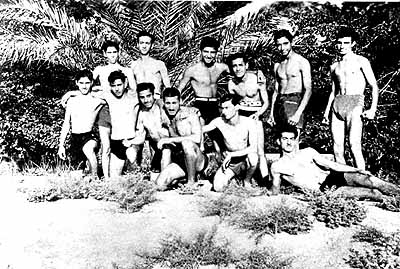
"Founded in the 1920s, the Zionist organization he-Halutz (The Pioneer) taught young German and Austrian Jews the essentials of farming.
After the Nazis gained power, the organization accelerated its training efforts.
Once members qualified for labor permits as skilled farmers, they could obtain permission to join the fortunate few legally permitted to enter Palestine."
August 27, 1942:
- "Eight thousand Jews from Wieliczka, Poland, are killed at the Belzec death camp.
- "When a transport train carrying 6000 Jews from Miedzyrzec, Poland, arrives at the Treblinka extermination camp, guards discover that nearly all of 6000 have died of suffocation during the 75-mile journey.
- "Several thousand Jews from Chortkov, Poland, are assembled in the town square and forced to witness the murders of the community's children; See August 28, 1942.
- "The Soviet defense of Stalingrad stiffens as the German siege intensifies.
- August 27-28: "Fourteen thousand Jews are killed at Sarny, Ukraine."
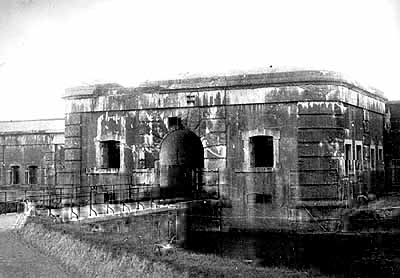
Breendonck "The concentration camp at Breendonck, Belgium, was a primary internment point for Jews in Occupied Belgium.
Located about 15 miles south of Antwerp, it was a moated fortress that dated from the early 1900s.
"The Nazis turned Breendonck into a place of internment in the summer of 1940, adding cells, gallows, barracks, a torture chamber, a site to drown prisoners and another to bury them alive, and quarters for the camp's SS and Wehrmacht overseers.
The prisoners' food and living conditions were execrable, and extreme physical cruelty was encouraged by the camp's head of forced labor, Artur Prauss.
"On September 24, 1942, Rabbi Dr. Salomon Ullman--chief Jewish chaplain of the Belgian military since 1937--was sent to Breendonck as a warning to resisters.
Ullman was released after 15 days; other Jewish detainees were not as fortunate.
When deportations of Jews from Belgium began in 1942, many Jewish prisoners held at Breendonck were sent to the Jewish transit camp at Mechelen before being condemned to Auschwitz.
"Breendonck's Belgian location and the harshness of its administrators "distinguish" it; Jews were never held there in great numbers, but all who were suffered terribly.
Between 1940 and 1944 the number of Jewish prisoners never exceeded 200, and by 1942 Jews no longer comprised the majority of inmates. The camp was liberated in the summer of 1944."
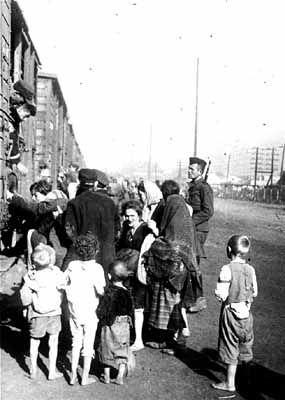
"This secretly taken photograph shows a transport train at the sta-tion at Siedlce, Poland.
This station was along one of the major routes between Warsaw and Treblinka, and many of the Jews deported during the liquidation of the Warsaw Ghetto passed through the station.
The Nazis tried to select out-of-the-way places for such activities in order to keep them secret from the local population.
But invariably some civilians knew what was going on."
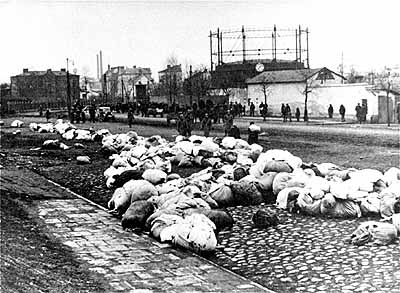
"The Nazis often ordered their victims to prepare bundles for their deportation journeys.
In Drogobych, Ukraine, 3000 Jews were ordered to prepare for resettlement and subsequent work in the Pripet Marshes.
Their bundles (pictured) never made it onto the train.
The 3000 Jews were shipped not to the Pripet Marshes but to the gas chambers at Belzec."
Now finally, again caught up to date:
August 28, 1942:
- "World Jewish Congress (WJC) President Stephen S. Wise receives a cable from Swiss WJC representative Gerhart Riegner regarding the "Final Solution."
Wise elects to suppress the information until it can be verified; See mid-November 1942. - "Ten thousand Jews are murdered at Miedzyrzec, Poland.
- "Jews of Chortkov, Ukraine, are put into freight cars and transported to the death camp at Belzec.
- "German authorities order the arrests of Parisian priests who have sheltered Jews."
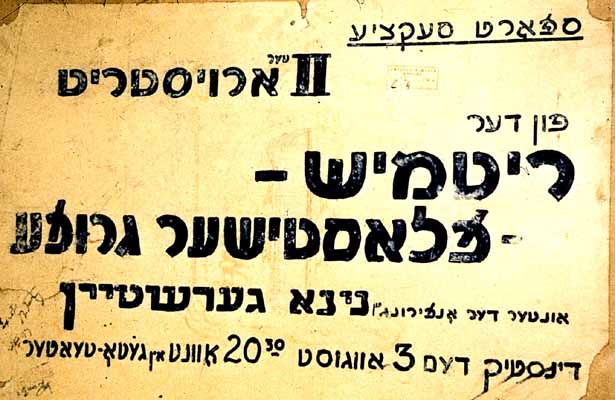
"While some Jews, such as Abba Kovner, sought to organize an underground resistance within the Vilna (Lithuania) Ghetto, others engaged in a different kind of community resistance.
Struggling to maintain the spirits of fearful ghetto residents, Jews in Vilna organized a variety of community cultural activities.
This poster, from August 1942, invites the community to attend a performance of the rhythmics and plastic arts group directed by Nina Gerstein."
August 29, 1942:
- "The Jewish community from Olesko, Ukraine, is deported to the Belzec death camp.
- "Occupation officials in the East inform Berlin that the "Jewish problem" has been "totally solved" in Serbia.
Since German occupation, 14,500 of Serbia's 16,000 Jews have been murdered."
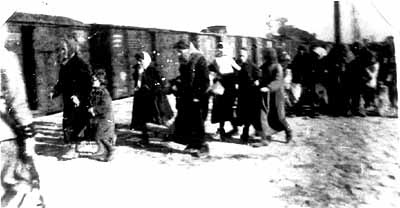
"On August 25-26, 1942, Jews of Miedzyrzec Podlaski, Poland, were boarded onto cattle cars and deported to Treblinka.
One of the jammed trains arrived with nearly all of the passengers dead from suffocation.
Abraham Jacob Krzepicki, a Jew who worked in the Treblinka death factory, remembered one of the 'survivors': 'Among those living I found a baby, a year or a year and a half old, who had woken up and was crying loudly.
I left him by the side. In the morning he was dead.' "
August 30, 1942:
- "Members of the Jewish community at Rabka, Poland, are murdered.
- "French Bishop Pierre-Marie Théas reminds his parishes that all human beings are created by the same God, Christians and Jews alike, and that 'all men regardless of race or religion deserve respect from individuals and governments.' "
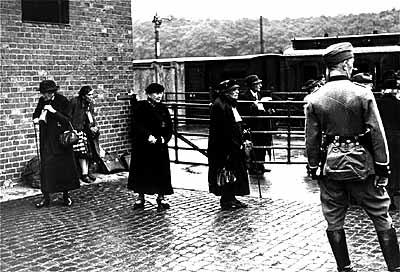
"Elderly deportees from the German city of Wiesbaden await the train that will transport them to an unknown location in the East.
The deportation of the 1006 "full-blooded" Wiesbaden Jews began in March 1942.
In addition to these individuals, other Wiesbaden Jews were deported to the East via Frankfurt.
Of the approximately 2800 members of the prewar Jewish community in Wiesbaden, only ten returned to their hometown after the war."
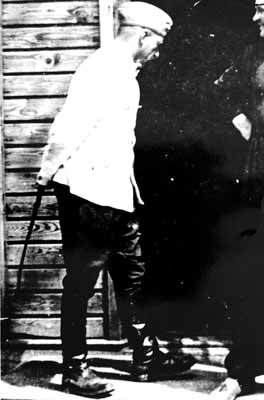
"An Austrian policeman who rose to the rank of SS captain, Franz Stangl commanded two of the six Nazi extermination centers in Poland: Sobibor and Treblinka.
"Under Stangl's supervision, Sobibor opened in early May 1942. By the end of July, about 100,000 Jews had been killed there.
Meanwhile, Stangl went to Treblinka.
Between 750,000 and 870,000 Jews were gassed there, most of them during Stangl's administration, which lasted from September of 1942 until the following August.
"After the war Stangl fled to Brazil.
In 1967 he was arrested, extradited to Germany, tried for his crimes, and sentenced to life imprisonment.
Journalist Gitta Sereny interviewed him in 1971.
"Do you think that that time in Poland taught you anything?" she asked Stangl on June 27.
"Yes," he replied. "That everything human has its origin in human weakness."
Less than 24 hours later, Stangl died of heart failure."
August 31, 1942:
- "Late summer 1942: SS officer Kurt Gerstein fails in his attempt to publicize his knowledge of the mass gassings of Jews.
He is rebuffed in his approach to the German papal nuncio, Cesare Orsenigo."
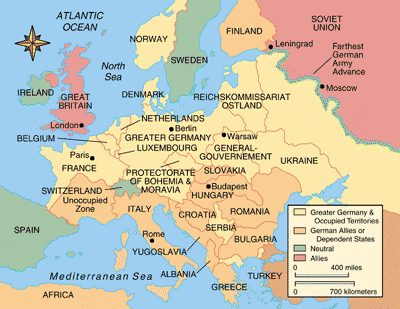
"By 1942 Germany had occupied most of Northern Europe, while most Southern European countries were ruled by pro-Nazi regimes.
In the East, German forces advanced deep into the Soviet Union.
In the second half of 1942, the Soviets began to push the Germans back."
Soviet Atrocities It’s been estimated that less than five percent of all German prisoners of war and probably less than one percent of all German wounded who were captured by the Soviets in 1941-42 ever returned home.
While there are numerous accounts of German atrocities in Soviet Russia [and elsewhere] during World War 2, very few detailed accounts exist, apart from those of German soldiers and their units, of Soviet atrocities committed against the Wehrmacht.
Recently I’ve come across a comprehensive German source referencing Soviet War Crimes against German troops on the Eastern Front that I think some may find interesting. That source is The Wehrmacht War Crimes Bureau of the High command of the Wehrmacht.
In International law, the Soviet Union generally stood outside the so-called community of states when it came to adhering to the Geneva Convention(s) concerning war prisoners.
Lenin had repudiated all agreements signed by the representatives of almost all nations in The Hague in 1907 as a legacy of the Czarist Empire.
It was the Czar who initiated this conference and whose representatives had worked decisively in the wording of the texts. The two Geneva Conferences of 1929 were never recognized by the Soviet Union.
This had the result that the treaties didn’t apply in wars involving the Soviet Union. When the Red Army marched into Eastern Poland in September 1939 in accordance with the Molotov-Ribbentrop Pact, members of the captured Polish Army {and untold thousands of civilians, priests and nuns, landowners, shop-owners and others} enjoyed no protection under international law. 12,500 Polish officers were murdered without the world learning anything about it. The Soviets set aside the provisions of international law in the Finnish-Soviet Winter War, as well. The request of the Finnish Minister of Foreign Affairs of 30 November 1939 that both sides should respect the terms of the Hague Convention of 1907 and the Geneva Convention of 1929 went unanswered.
During the Second World War, these treaties were applicable between the German Reich and its allies on the one hand and the Western Allies on the other hand, but not between the German Reich and the Soviet Union.
Whether or not Stalin’s offer to the German Ministry of Foreign Affairs dated 17 July 1941, forwarded through Sweden as the representative protecting power of the USSR, stating that he would be prepared to treat prisoners of war in accordance with international law if the Germans would do the same, created a mutual obligation, is disputed. Germany answered with a protest note:
"The Reich Government can only express its extreme astonishment that the Soviet government, despite the attitude of its troops against German soldiers that have fallen into their hands so far, still considers itself justified in speaking of the application of the regulations of international law in the treatment of prisoners of war and, at the same time, in bringing up the subject of reciprocity… On the other hand, it has been established, based on the condition of German soldiers found during the advance of the German troops, as well as by the testimonies of soldiers having temporarily fallen into the hands of Russian troops and then having been liberated, some of whom were wounded, that the Soviet troops have martyred and tortured German prisoners in a truly indescribable and bestial manner".
It would turn out that the employment of words like indescribable and bestial in that protest note was only too truthful
German soldiers were habitually robbed of all personal possessions immediately after capture. While being searched for weapons, they were robbed of all valuables, especially watches and rings. They were often robbed of their boots as well, which was equivalent to a death sentence: anyone without solid footwear died on the long marches.
Many of these plundered captives, if any remained alive at all, were later shot individually or in groups. The shooting of prisoners occurred so extensively that the Red Army intelligence service grumbled about a lack of POWs to interrogate. The Red Army high command had difficulty gaining intelligence about enemy positions and details about the German units, for example, armaments and supplies. The Commander in Chief of the Red Army therefore ordered an end to the practice of shooting all prisoners—which, to the Soviets at the front lines, appeared comprehensible and legal to them; German POWs were henceforth to be sent to the rear, instead of being shot.
Needless to say, It did little good
Reference to Article 5 of the Prisoner of War Convention was superfluous: “Every prisoner of war is required to declare… his true names and rank, or his regimental number… No pressure shall be exercised on prisoners to obtain information regarding the situation in their armed forces or their country. Prisoners who refuse to reply may not be threatened, insulted, or exposed to unpleasantness or disadvantages of any kind whatsoever.” The Soviet command authorities issued many orders, which are still in existence, to shoot all prisoners of war unwilling to make a statement. Many interrogations were accompanied by torture. The simplest method of interrogation consisted of holding the soldier by both hands and feet and striking him with a truncheon up to ten times on the buttocks and back to make him talk. More severe interrogation consisted of stripping the prisoner naked and beating him about the head with rubber truncheons until the ears fell off. Other persons unwilling to talk had their fingernails torn out. After the interrogations, the prisoner was usually handed over to the N.K.V.D. where, as a rule, they were again tortured, then shot.
Soviet POW war camps, throughout the war, were little different from German POW camps in the fall of 1941, where hundreds of thousands of Red Army members died, from one day to the next, in a land bled white after great battles of encirclement. The number of German soldiers who died in captivity from punishment measures, exhaustion, hunger, dysentery, typhoid, typhus and overwork can never be known. The sick and the wounded nearly all died.
One of the first great show trials of German prisoners of war took place in Kharkov in December 1943. The four defendants were hanged publicly after four days of the trial on 19 December 1943 in the city marketplace, to the applause of 50,000 screaming spectators.
*Abuse of the Red Cross* During the Second World War, all the belligerents were guilty of violations of the 1929 Geneva Prisoner of War Convention. The emblem of the Red Cross was misused and abused. But German wounded who fell into the hands of the Red Army were particularly vulnerable to hostile brutality.
Members of the Red Army were under no obligations under international law. Even the “Martens Clause” remained a dead letter. The “Martens Clause”, of course, referred to the customs of civilized nations, the laws of humanity and the requirements of public conscience, but all these notions were corrupted by Socialist education in class hatred. The treatment received by German wounded depended on the personal morals of the individual Russian soldier. Those with religious convictions might, in individual cases, have recognized wounded Germans as helpless fellow brothers in Christ, but most of them adhered to the morals of the Party, which considered the Germans mere vermin.
The Soviet military leadership ignored the emblems of the Red Cross since the beginning of the war. German field hospitals and forward collection points marked with a visible Red Cross flag came under fire so frequently that, in the end, the Red Cross flag was no longer flown, since it offered no protection. Since unarmed German medics (and surgeons) wearing Red Cross armbands were murdered upon capture, together with the wounded, they were issued .38 caliber pistols to protect the wounded. To protect them from sniper fire, German medics were even prohibited from wearing the Red Cross armband, since it provided a highly visible target.
When German wounded were left on the field and fell into the hands of the Red Army, their fate was entirely a matter of chance. Many were blown up inside the buildings in which they lay; sometimes they were evacuated with the Red Army where they usually disappeared; in Feodosia, they were simply thrown out of the windows or stripped naked in the December below freezing weather and thrown into the Black Sea.
The investigative results of the Wehrmacht War Crimes Bureau covered 226 volumes of documents by the end of the war. These volumes covered approximately 8,000 documented cases.
*The Wehrmacht War Crimes Bureau in the High command of the Wehrmacht The Wehrmacht began the Second World War in the belief that there would be no large-scale violations of international law (at least by their opponents). But the excesses of the Poles against the ethnic German minorities and wounded German soldiers in the first days of the war soon caused the Wehrmacht leadership to form an official investigative agency.
It was suggested by the Operations Division in the Wehrmacht operations staff and approved by Hitler as Commander in Chief of the Wehrmacht. The corresponding order of 4 September 1939, signed by General Keitel as Chief of the OKW, read: “At the High command of the Wehrmacht (Wehrmachtrechtabteilung or Armed Forces Legal Division) a ‘Wehrmacht Untersuchungsstelle für Verletzungen des Volkerrechts’ [“Armed Forces Agency for the Investigation of Violations of International Law”] has been formed with the task of establishing violations of international law by enemy military personnel and civilians against members of the German Wehrmacht and, at the same time, of clarifying accusations raised by foreign countries against the German Wehrmacht in this regard. The courts of the Wehrmacht are requested to correspond to the requests of the above mentioned agencies for proof investigations, especially in the interrogation of witnesses and experts as well as their defense.” On 10 October 1939, the civilian lower courts were ordered to cooperate by the Reich Ministry of Justice.
After the beginning of the Russian campaign, the “Special Command of the OKW for the Investigation of Bolshevist Atrocities and Actions in Violation of International Law” was formed under the leadership of Prof. Dr. Gerhard Buhtz, medical expert at the University of Breslau. The first report on violations of international law in the field of the Army Group North was delivered on 4 December 1941. With regard to the Army Groups Center and South, the Medical Inspector in the OKH took over the tasks for forensic medical expert reports on victims of war crimes. On 27 August 1941, he assigned several specialists in forensic medicine “to clarify violations of international law and treatments of the Bolsheviks”.
The German Foreign Office maintained liaison officers to the Army High commands on the Eastern Front, who were concerned with copies of sworn interrogations of eyewitnesses and of captured papers for the Central Agency. The German Foreign Office also bore the costs of the “Russian-German Committee for the Establishment of Soviet Russian Atrocities against German and Russian Soldiers” which was compiled in April 1942 by the Ambassador, Otto von Hentig, at the High Command of the 11th Army, to investigate Soviet human rights violations against German soldiers. The most important sources were members of the Wehrmacht who had escaped from the Soviets. In the sworn interrogations they reported on atrocities to which they had been witnesses.
In order to ensure that the documentation obtained would stand up under international law and according to the standards of forensic medicine, great value was placed on the formal establishment of facts.
All interrogations of eyewitnesses were entered into a written record. The record was signed, not only by the interrogated persons, but by the interrogating judges and secretary. The witnesses were sworn. The oath was only neglected when the report consisted of hearsay.
To ensure accuracy of content, several witnesses were interrogated on the same case whenever possible. For example, in the case of the massacre of 150 to 200 German prisoners of war in Broniki (Ukraine), a total of 12 witnesses were interrogated by a total of 4 judges. Whenever possible, the interrogating judge confirmed the facts of the case through on the spot inspection.
For worldwide publication, the German Foreign Office, in 1941 and 1942, published a "White Book on Soviet War Crimes on the Eastern Front" in every case.
For 1943, a third volume was in preparation. The intent was to enlighten the Western Allies as to the crimes of their Ally while warning the neutral powers of the dangers of Bolshevism. The books bore the title "Bolshevist Crimes against the Laws of War and Humanity".
All volumes contained horrifying examples of murders of prisoners and wounded soldiers, the veracity of which could not be doubted because of the exact time, place, and detailed eyewitness testimonies. The facts of the case were supplemented by emotional appeals and polemical remarks. In the introduction to the first volume, which was primarily concerned with Soviet atrocities against the civilian population, using examples taken from the massacres at Lemberg, the following sentence appears:
"*Many thousands of members of the Ukrainian people were thrown into prison, subjected to all conceivable forms of mistreatment and torture and finally slaughtered under fearful circumstances. The Bolshevik murderers spared neither women, nor children, nor priests. In addition to the mountains of corpses found in the cellars of the prisons after the liberation of Lemberg, more than 30 corpses of children were found, some of them hanging from the ceiling by hooks in their mouths, some of them crucified to the walls*".
The second volume gave priority to the fate of German soldiers in Soviet captivity:
"*With their hands tied together, their eyes were put out, their tongue, nose, ears and genitals were cut off, the corpse was torn to pieces with bayonet wounds. The screams of pain from the tortured persons and the distorted expressions on the faces of the cruelly mutilated bodies indicate the excruciating tortures by means of which the dehumanized beasts expressed their sense of bloodthirsty exhilaration upon the unhappy victims*".
Among the troops, there was no doubt as to the truthfulness of the German atrocity reports.
Anyone who mistrusted National Socialist propaganda found confirmation in the tales of soldiers returning from the Eastern Front. Resistance was offered in obviously hopeless military situations simply because every soldier wished to avoid being taken prisoner [by the Soviets]. In the event of capture, he had to assume that he would be robbed, tortured, shot or sent to Siberia for forced labor. The German propaganda slogan “Victory or Siberia” seemed quite believable. During the last months of the war, in the face of defeat, German propaganda even adopted the popular joke “Enjoy the war, the peace will be terrible” to encourage the last vestige of any will to resist. Almost no one doubted the enemy’s tendency towards destruction, even though the longing for peace was growing greater by the day.
Of the total of 226 original document volumes of the Wehrmacht War Crimes Bureau, many are no longer available today in the Freiburg Military Archives; nor have they been for many years. Confiscated and transported to America as "captured documents', the collection was only returned to Freiburg in 1968, and then only in incomplete form.
Next to the absence of complete documents, the disappearance of the majority of the original photographs is particularly distressing.
In this sense, it is a fortunate accident of contemporary history that the War Crimes Bureau itself undertook an evaluation of its research findings organized on the basis of years of publication, preparing one volume of text, containing a summary of the individual investigative findings, for both 1941 and 1942, in addition to two volumes of documents for both years, including witness interrogations, expert opinions and much additional material. The mimeographed text volumes contain extracts from the original photographs, on photographic paper, so that these irreplaceable documents have been rescued for posterity.
As will be seen from the examples to follow-Soviet Russia engaged in atrocities almost from the first minutes of the war.
Next-Actual Cases of Soviet Atrocities